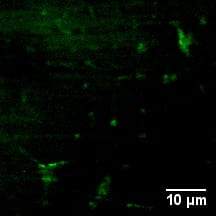Little green flashes unlock secrets of catalytic reactions

UCI researchers have devised a new fluorescence microscopy technique for observing individual molecules during catalytic reactions. Their work, published recently in the prestigious German journal Angewandte Chemie, is aimed at helping scientists and engineers better understand the fundamental workings of catalysis, the basis of multibillion-dollar industries in polymer plastics and pharmaceuticals. “Most studies of catalytic reactions examine billions of molecules at a time, forcing you to draw conclusions from an average measurement,” said lead author Quinn Easter, a graduate student in UCI’s Department of Chemistry. “Our technique allows you to pinpoint the exact location of an individual reaction.” To do this, the researchers designed a fluorescent probe molecule that both participates in reactions and emits a tiny green light to signify its location during catalysis. They also employed a camera/microscope instrument with such sensitivity that it can detect a green flash from one in 100 billion molecules. “Our experiments provided a unique resolution of the environment of catalysts that was previously unobtainable through averaging,” said co-author Suzanne Blum, UCI professor of chemistry. “In the long term, this work could provide guiding information for the development of more efficient catalysts that require less energy and produce less waste, or which are cheaper to make and use.”